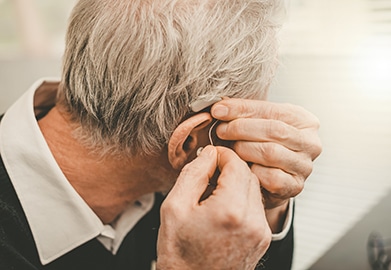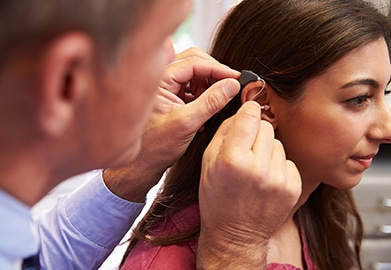Useful Care and Cleaning Tips for Hearing Aids During COVID-19


One of the recommendations to help protect yourself from the coronavirus is to avoid touching your face. However, as a hearing aid user, you may have a habit of repositioning your device, changing listening programs, and other similar practices. If you are looking for ways to safely manage your hearing aids during the COVID-19 pandemic, our hearing professionals have put together a few useful tips for you.
Tips to Maintain Your Hearing Device During COVID-19
- Clean Your Hands Before & After Handling Your Hearing Aids Before touching your hearing device, be sure to you wash your hands thoroughly. Doing so can help stop bacterial transmission. If the hearing aid is removed from your ear, use a hearing aid sanitizer or sanitizer wipe (available at your hearing clinic) to clean the hearing aid casing. Once you have finished adjusting your hearing aids, clean your hands again.
- Control Your Hearing Aids Using Technology If your hearing aid has a remote-control option, now is a great time to start using it. This way, you can limit how often you touch your device’s program or volume button for simple program and volume changes. If your hearing aids have wireless technology inside and are compatible with your smartphone, they can be controlled using an app. Ask you hearing aid provider if these options are available with your hearing aids.
- Have a Proper Cleaning Schedule It is best to develop and maintain a strict and consistent cleaning schedule. This includes wiping and sanitizing your hearing aids every night and cleaning them more thoroughly on regular basis to ensure they are in good working condition. This may include maintenance of your hearing aid’s wax guards, mic guards, domes, microphone ports and battery contacts. It will help to avoid additional repairs and extra visits to the hearing clinic for servicing.
- Take the Device Out Over a Soft Surface To avoid any damage to your hearing devices when cleaning them, remove them over a soft surface. This ensures that your hearing aid won’t fall onto a hard counter or table. You can place a towel or cloth over a hard surface to soften it.
- Store Your Hearing Devices at Room Temperature Place your hearing aids in a secure place at room temperature and ensure they are dry. Keep them in a proper case to avoid accidentally knocking them off your table and protect them from spills. Hearing aid Dry-aid kits (hearing aid dehumidifiers) are available at your hearing aid provider clinic.
- COVID-19 19 Masks and Hearing Aids It is easy to lose your hearing aids while removing or adjusting the COVID-19 mask. Please pay attention when doing so. We are often caught off guard, concentrating on putting on or removing the mask while entering a store or office, often forgetting that there is a pair of hearing aids on our ears. The RIC (receiver-in-the-canal style) behind the ear style hearing aids are most prone to be lost this way. If it does happen, contact your hearing aid clinic and find out if your aids are still under the loss & damage policy.
Caring for Your Hearing Aid
Shell and Faceplate (Custom In-The-Canal Hearing Aids)
This is the outer surface of the hearing aid. Debris or wax accumulation can alter the fit, causing discomfort, or affect and block parts such as volume controls, program buttons and microphone ports. You can clean around them with the brush that comes with the device. Use a hearing aid sanitizer and a cloth on the acrylic shell.
Microphone
The microphone is a delicate part of the hearing aid that should be cleaned only with the brush. Turn your hearing aid so the microphone faces down, and debris falls away from it. Gently sweep the microphone port with the brush to remove any buildup. If your device features mic guards or mic caps on the microphone ports, replace them on as needed basis. Replacement mic guards and mic caps can be purchased form your hearing aid provider.
Receivers, Domes and Wax Guards.
You can clean the receiver opening of your hearing aid (speaker opening) daily using the brush to prevent wax accumulation. If the receiver is blocked, the sound will be muted. Most hearing aids have wax guards on the receivers. Some, like the RIC style (receiver-in-the-canal) hearing aids may have rubber domes at the tip of the receiver wire. Both the domes and the wax guards can and should be replaced periodically. Ask you hearing aid specialist about it.
Bravo Hearing Offers Comprehensive Hearing-Related Services
At Bravo Hearing, we go beyond offering hearing aids and providing hearing tests. We have qualified hearing loss specialists who can examine your ears and overall hearing health and recommend the most suitable course of action. We also offer hearing aid accessories, wax guards, batteries, sanitizer sprays, dry-aid kits, custom earmolds, sleep plugs, musician ear plugs and more.
For more details about our services, call us at 416-207-9711. You could also visit our e-store to see the hearing aids we carry or fill out our online form to book a hearing test.
Also Read:


